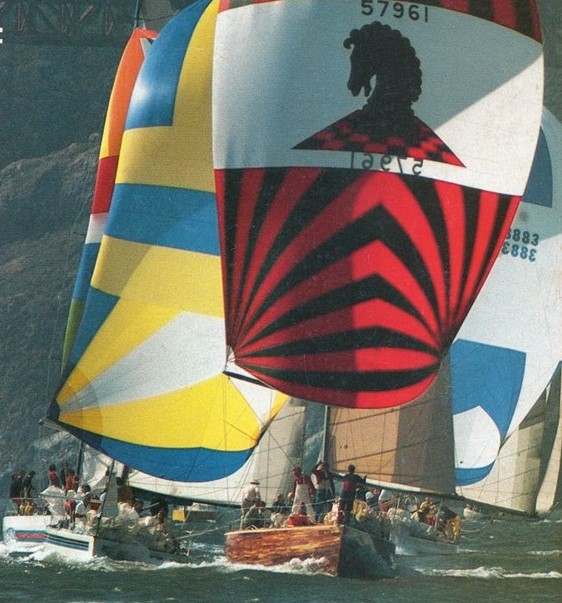Checkmate is a 50 foot Doug Peterson design (Design #61, with input from Design Associates Bill Tripp and Bill Hardin) for US yachtsman Monte Livingston, and which was launched in April 1978. She was notable for her varnished topsides that showed off a Meranti veneer over her Cedar plank construction (and her glossy finish remains to this day). Checkmate was lighter and featured wider stern sections than typical Peterson designs of the time, and was aimed at doing well in the light air downwind races to Mexico on the US West Coast. These characteristics contributed to a reasonably high rating for a 50-footer of 42.6ft IOR.
 |
| Checkmate on launching day, 7 April 1978 (photo courtesy Doug Peterson Collection) |
 |
| Profile, sail plan and interior arrangement drawing of Checkmate |
 |
| Checkmate on her launching day, 7 April 1978 (photo courtesy Doug Peterson Collection) |
Checkmate raced in the inaugural 1978 Clipper Cup where she finished a very creditable 7th place in the 39-boat fleet. She went on to establish an outright elapsed time record in the La Paz Race in 1979 (where she also finished second overall and first in Class A), and held this record for about 20 years.
 |
| Checkmate sailing off Molokai in 1978, before that year's Clipper Cup (photo Phil Uhl) |
The original Checkmate is sometimes confused with the Peterson 55 Bullfrog, which she campaigned alongside in the 1982 Clipper Cup, where Checkmate managed a podium position in Class B (third) after Bullfrog broke her forestay while leading overall and in class (finishing fourth in Class B). Bullfrog was later taken over by Livingston and his Checkmate team, and was renamed accordingly. This later Checkmate sailed with great success in the 1984 Clipper Cup, finishing fourth overall (1/1/3/1/15) and was a member of the winning USA White team, alongside Tomahawk and Camouflage.
 |
| Checkmate leads Zamazaan and Great Fun during the 1982 Big Boat Series in San Francisco (Yachting magazine cover, photo J Eisberg, Doug Peterson Tribute page) |
 |
| Checkmate and the Farr-designed Sangvind running downwind in San Francisco (Doug Peterson Tribute page) |
It was expected that the original Checkmate would sail in the 2017 Rolex Sydney-Hobart Yacht Race as Checkmate of Hollywood, but unfortunately the boat wasn't quite ready on time. The yacht profile from the Sydney-Hobart 2017 website provides some detail on the boat and her crew for the race:
"A change of pace for Ray ‘Hollywood’ Roberts who has chartered the 40 year-old IOR Doug Peterson designed Checkmate, built in San Diego by the famous Carl Eichenlaub, but updated in 2000 to make her a fast, comfortable boat. Roberts sailed Hollywood Boulevard, his Farr 55, to 36th overall for fifth in Division 1 in the Sydney Hobart last year, then placed fourth overall in the Brisbane Gladstone Race.... Roberts says Checkmate is a special (yacht), one of the last cold-moulded wooden boats. "It’s a showpiece and with her age allowance, we could be half a chance.”
 |
| Checkmate sailing upwind (above and below) after a recent restoration and while still based in the US |
While Checkmate wasn't ready for the Sydney-Hobart, she made the startline for the 360nm Pittwater to Paradise Race (from north Sydney to the Gold Coast). Crew member Michael Spies reported that, with some good yardsticks in the fleet, including the Australian IRC champion Nine Dragons, it provided the perfect race to see where the boat was at performance-wise. Checkmate was fitted with a complete new sail inventory including main, J1, J2, J5, S2, S4, staysails and even a blooper. Headsails were intentionally built smaller to reduce the IRC rating (to 1.113). The bottom was completely re-done and the foils faired and optimised.
 |
| Checkmate after a recent restoration and while still based in the US |
All the work paid off, and Checkmate won all the handicap prizes (IRC, ORCi and PHRF), and finished fifth on line (in the 17 boat fleet). Spies commented afterwards that "It was our first Australian race, after the disappointment of missing the Hobart. We backed ourselves. The competition wasn’t soft. Nine Dragons is an Australian champion. It wasn’t ideal conditions for our boat, but the boat lived up to our expectations – more than! Having run grand prix boats for 30 years, with a world champion crew, a mix of youth and experience, Checkmate was vastly different. It’s a 40 year-old timber boat, not carbon fibre. She’s a lot harder to steer, but more forgiving in motion, not as hard on the body. It was nice to have a hot meal and good sleep. We actually had an oven! It just proves the IRC rule is doing its job".
 |
| Checkmate of Hollywood on her way to overall honours in the 2017 Pittwater to Paradise Race (photo Sailworld/Howard Wright IMAGE Professional Photography) |
Spies added "Full credit to Ray Roberts and his enthusiasm for Checkmate and supporting this event. He had a vision and supported getting this boat back to Australia. For the crew, it was different, we worked hard without breaking the boat, learning about it on the way. There’s a lot of depth of talent and we prepared well for Hobart with new sails, which were flying for the first time in the P2P.”
Regatta information and results here.
Article updated October 2023

















































